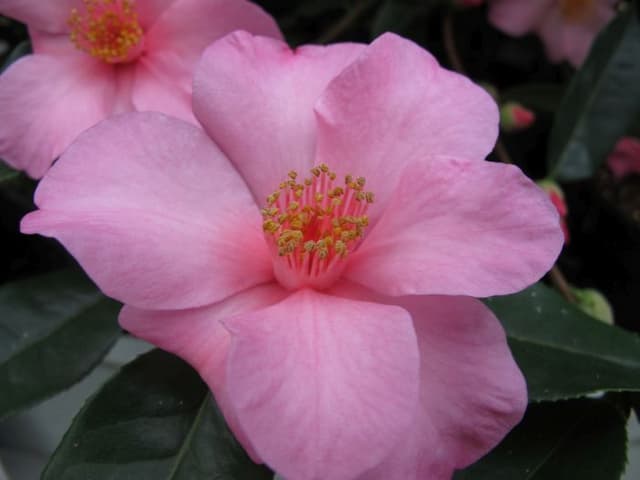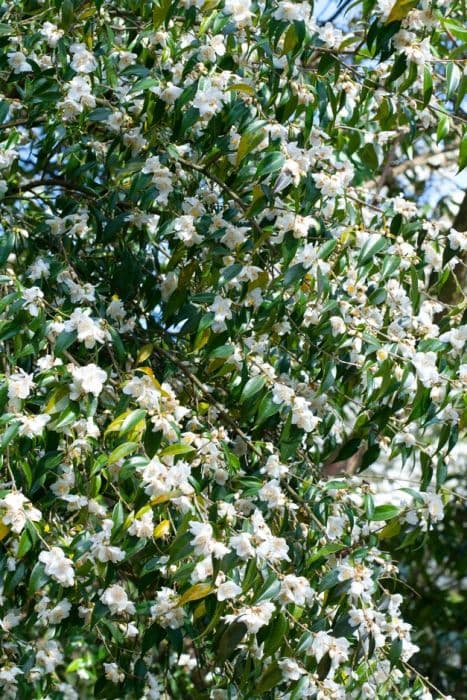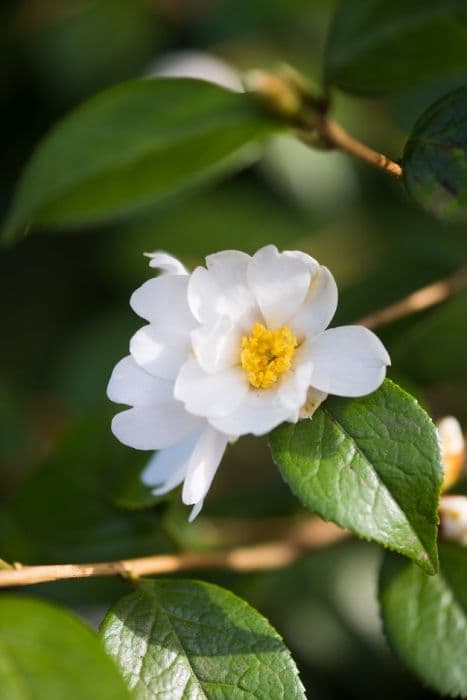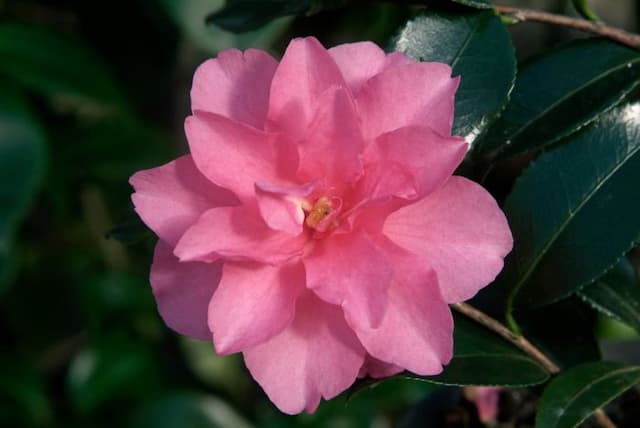Camellia 'Sparkling Burgundy' Camellia 'Sparkling Burgundy'

ABOUT
'Sparking Burgundy' has an upright, compact habit and showy peony-shaped flowers in shades of ruby red with a lavender sheen; flowers produced from early winter to early spring
About this plant
 Names
NamesFamily
Theaceae
Synonyms
Sparkling Burgundy Camellia
Common names
Camellia 'Sparkling Burgundy'.
 Characteristics
CharacteristicsLife cycle
Perennials
Foliage type
Evergreen
Color of leaves
Dark green
Flower color
Pink
Height
6-10 feet (1.8-3 meters)
Spread
6-10 feet (1.8-3 meters)
Plant type
Shrub
Hardiness zones
7
Native area
Asia
Benefits
 General Benefits
General Benefits- Ornamental Appeal: Camellia 'Sparkling Burgundy' is known for its stunning burgundy flowers which add a pop of rich color to gardens and landscapes.
- Year-Round Interest: The glossy evergreen foliage provides interest throughout the year, even when the plant is not in bloom.
- Shade Tolerance: Camellias generally do well in partial shade, making them suitable for understory planting or north-facing gardens where other flowering plants might struggle.
- Breeding Potential: Gardeners and breeders value this cultivar for its unique color and may use it to develop new hybrids and varieties of camellias.
- Long Blooming Period: Camellias, including the 'Sparkling Burgundy', often have a prolonged blooming season, which can span from late fall to early spring depending on the climate, providing flowers during a time when few other plants are in bloom.
- Drought Resistance: Once established, camellias can be relatively drought-tolerant, requiring less frequent watering compared to many other ornamentals.
- Pollinator Attraction: While Camellia 'Sparkling Burgundy' is not as significant for pollinators as some other flowering plants, it can still attract bees and other beneficial insects during its blooming period.
- Versatility in Landscaping: This plant can be used for various landscaping purposes, including as a specimen plant, in mixed borders, or as part of a camellia collection.
- Low Maintenance: Camellias are generally low-maintenance plants, requiring minimal pruning and care once they are well established in the landscape.
- Resistant to Pests and Diseases: Camellias are relatively resistant to many pests and diseases, which helps reduce the need for chemical treatments in the garden.
 Medical Properties
Medical PropertiesThis plant is not used for medical purposes.
 Air-purifying Qualities
Air-purifying QualitiesThis plant is not specifically known for air purifying qualities.
 Other Uses
Other Uses- Floral Arrangements: The Camellia 'Sparkling Burgundy' can be used in floral arrangements for its stunning flowers, providing a rich, dramatic accent in bouquets and centerpieces.
- Natural Fabric Dye: The petals of the Camellia can be used to produce a natural dye for fabrics, giving them a delicate pink to burgundy hue, depending on the mordant used.
- Photography Subject: The vibrant and distinct colors of the Camellia 'Sparkling Burgundy' make it an excellent subject for photographers specializing in botanical imagery.
- Crafting: The dried petals can be incorporated into various crafts such as homemade paper, potpourri, or even pressed flower art.
- Tea Flavoring: While not the tea camellia, the petals of the 'Sparkling Burgundy' can be used to add floral notes to homemade tea blends.
- Edible Garnish: The petals of this Camellia are edible and can be used to add a splash of color as a garnish on salads or desserts.
- Frost Protection in Horticulture: The fallen leaves can be used as mulch to protect more sensitive plants from frost, acting as an insulating layer.
- Insectary Plant: The Camellia 'Sparkling Burgundy' can attract beneficial insects to the garden, serving as a companion plant that supports biodiversity.
- Bookmarks: Dried petals or leaves can be laminated to create unique and beautiful botanical bookmarks.
- Bonsai Specimen: With proper training and care, this variety of Camellia can be cultivated as a bonsai, adding an exotic touch to the collection.
Interesting Facts
 Feng Shui
Feng ShuiThe Camellia is not used in Feng Shui practice.
 Zodiac Sign Compitability
Zodiac Sign CompitabilityThe Camellia is not used in astrology practice.
 Plant Symbolism
Plant Symbolism- Adoration: Camellia flowers are often associated with deep adoration between individuals, much like the intense color of the 'Sparkling Burgundy' cultivar.
- Perfection: The flawless form of the Camellia represents the ideal or perfection, which is mirrored in the symmetrical blooms of 'Sparkling Burgundy'.
- Enduring Love: Given as a gift, Camellias symbolize love that is lasting and beyond the superficial, akin to the durable nature of 'Sparkling Burgundy’s' blooms.
- Refinement: Camellias can indicate a sense of refinement and sophistication, echoing the elegant appearance of the 'Sparkling Burgundy' variety.
- Longevity: The Camellia plant’s longevity as an evergreen is often seen as a symbol of life and longevity, which also applies to 'Sparkling Burgundy'.
 Water
WaterSparkling Burgundy Camellias should be watered deeply to encourage a strong root system, receiving about 1 to 1.5 inches of water weekly. During the growing season, particularly in the absence of rainfall, ensure the soil remains moist but not waterlogged. In hotter seasons, they may need water twice a week, while in cooler seasons, once a week could be sufficient. Always check the top layer of soil for dryness before watering. Gradually pour over the ground, allowing the water to seep into the soil rather than running off, using about 2 gallons per week for an established plant, adjusting as necessary based on rainfall and temperature conditions.
 Light
LightSparkling Burgundy Camellias prefer partial shade where they receive filtered sunlight or morning light with protection from harsh afternoon sun. Ideal locations include eastern exposures or beneath high-canopied trees that provide dappled light throughout the day. They can handle more sun in cooler climates but may require shading in warmer areas to prevent leaf scorch.
 Temperature
TemperatureSparkling Burgundy Camellias thrive in temperatures between 60 to 80 degrees Fahrenheit but can tolerate a range from 20 to 90 degrees Fahrenheit. They prefer a cooler climate and may struggle with high temperatures during summer without adequate shade and hydration. Ideal temperature conditions align with those of their natural habitat, offering warmth without extremes.
 Pruning
PruningPrune Sparkling Burgundy Camellias to maintain shape and encourage air circulation within the canopy. The best time for pruning is immediately after blooming, as they set next year's flower buds soon after. Light pruning can be done annually; however, extensive pruning should be done less frequently, as needed, to rejuvenate older plants.
 Cleaning
CleaningAs needed
 Soil
SoilThe Camellia, commonly known as the Sparkling Burgundy, thrives in acidic soil with a pH of 5.5 to 6.5. A good soil mix for this plant would be one part each of well-draining loam, peat moss, and perlite or sand to ensure good drainage and aeration. Amend with organic compost to provide necessary nutrients and maintain soil structure.
 Repotting
RepottingCamellias generally need to be repotted every 2 to 3 years or when the root system outgrows the pot. The best time to repot Camellias is in the late winter or early spring, just before they enter their growth cycle.
 Humidity & Misting
Humidity & MistingCamellias require moderate to high humidity, ideally between 40% to 60%. They benefit from a humid environment, especially during the drier winter months. Grouping plants together or using a pebble tray can help maintain adequate humidity levels.
 Suitable locations
Suitable locationsIndoor
Provide bright, filtered light and consistent moisture.
Outdoor
Place in part shade, shelter from hot afternoon sun.
Hardiness zone
7-9 USDA
 Life cycle
Life cycleCamellia 'Sparkling Burgundy', commonly known as Sparkling Burgundy Camellia, initiates its life cycle when a seed germinates, often in late winter or early spring. The seedling then grows into a young plant, developing roots, stems, and leaves. In subsequent years, the camellia matures into a bushy evergreen shrub, with glossy, dark green leaves providing year-round interest. The plant enters its reproductive stage, usually in the fall to winter months, producing large, peony-form blooms that are deep pink to red. After pollination, typically by insects, the flowers form seed pods that mature and eventually release seeds, completing the cycle. Throughout its life, which can span several decades, the plant undergoes seasonal growth cycles, with new leaf growth in spring and bud set in late summer.
 Propogation
PropogationPropogation time
Spring-Early Summer
The Camellia 'Sparkling Burgundy', commonly known as the Sparkling Burgundy Camellia, is most commonly propagated through semi-hardwood cuttings. This method takes place during the late summer months when the new growth has matured enough to be neither too soft nor too woody. To propagate, a cutting of about 4 to 6 inches (10 to 15 centimeters) is taken from a healthy parent plant, ensuring that it has at least two to three sets of leaves. The lower leaves are removed, and the cut end may be dipped in rooting hormone to encourage root development. The cutting is then planted in a well-draining growing medium, ensuring the leaf nodes (where the leaves were removed) are buried, as roots will develop from these points. The environment should be kept humid, which is often achieved by placing a plastic cover over the cutting while ensuring good ventilation to prevent rot. With proper care, the cutting will root and can eventually be transplanted to a desired location in the garden.









